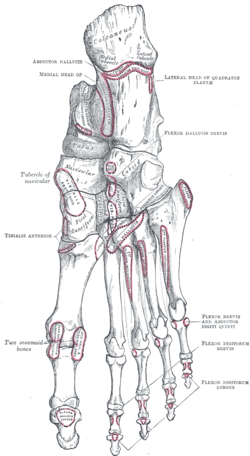Plantar interossei muscles
| Plantar interossei muscles | |
|---|---|
 The Interossei plantares. Left foot. | |
| Details | |
| Origin | Metatarsals |
| Insertion | Proximal phalanges |
| Artery | Plantar Artery, and Dorsal Metatarsal A |
| Nerve | Lateral plantar nerve |
| Actions | adduct toes |
| Antagonist | Dorsal interossei of the foot |
| Identifiers | |
| Latin | Musculi interossei plantares |
| TA | A04.7.02.071 |
| FMA | 37458 |
In human anatomy, plantar interossei muscles are three muscles located between the metatarsal bones in the foot.
Structure
The three plantar interosseous muscles are unipennate and originate on a single metatarsal bone. The three muscles originate on the medial aspect of metatarsals III-V. The muscles cross the metatarsophalangeal joint of toes III-V so the insertions correspond with the origin and there is no crossing between toes.[1]
The muscles then continue distally along the foot and insert in the proximal phalanges III-V. The muscles cross the metatarsophalangeal joint of toes III-V so the insertions correspond with the origin and there is no crossing between toes.[1]
Innervation
All of three interosseous muscles are innervated by the lateral plantar nerve. The lateral plantar nerve is a branch from the tibial nerve, which originally branches off of the sciatic nerve from the sacral plexus.[1]
Function
Since the intersseous muscles cross on the metatarsophalangeal joint, then they act on that specific joint and cause adduction of toes III, IV, and V.[1]
Adduction itself is not of extreme importance to the toes, but these muscles work together with the dorsal interosseous muscles in flexion of the foot. They also work together to strengthen the metatarsal arch.[2]
Additional images
 Bones of the right foot. Plantar surface.
Bones of the right foot. Plantar surface.- Muscles of the sole of the foot.
See also
References
This article incorporates text in the public domain from the 20th edition of Gray's Anatomy (1918)